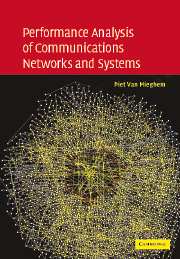Book contents
- Frontmatter
- Contents
- Preface
- 1 Introduction
- Part I Probability theory
- Part II Stochastic processes
- 7 The Poisson process
- 8 Renewal theory
- 9 Discrete-time Markov chains
- 10 Continuous-time Markov chains
- 11 Applications of Markov chains
- 12 Branching processes
- 13 General queueing theory
- 14 Queueing models
- Part III Physics of networks
- Appendix A Stochastic matrices
- Appendix B Algebraic graph theory
- Appendix C Solutions of problems
- Bibliography
- Index
14 - Queueing models
from Part II - Stochastic processes
Published online by Cambridge University Press: 22 February 2010
- Frontmatter
- Contents
- Preface
- 1 Introduction
- Part I Probability theory
- Part II Stochastic processes
- 7 The Poisson process
- 8 Renewal theory
- 9 Discrete-time Markov chains
- 10 Continuous-time Markov chains
- 11 Applications of Markov chains
- 12 Branching processes
- 13 General queueing theory
- 14 Queueing models
- Part III Physics of networks
- Appendix A Stochastic matrices
- Appendix B Algebraic graph theory
- Appendix C Solutions of problems
- Bibliography
- Index
Summary
This chapter presents some of the simplest and most basic queueing models. Unfortunately, most queueing problems are not available in analytic form and many queueing problems require a specific and sometimes tailor-made solution.
Beside the simple and classical queueing models, we also present two other exact solvable models that have played a key role in the development of Asynchronous Transfer Mode (ATM). In these ATM queueing systems the service discipline is deterministic and only the arrival process is the distinguishing element. The first is the N*D/D/1 queue (Roberts, 1991, Section 6.2) whose solution relies on the Beneš approach. The arrivals consist of N periodic sources each with period of D time slots, but randomly phased with respect to each other. The second model is the fluid flow model of Anick et al. (1982), known as the AMS-queue, which considers N on-off sources as input. The solution uses Markov theory. Since the Markov transition probability matrix has a special tri-band diagonal structure, the eigenvector and eigenvalue decomposition can be computed analytically.
We would like to refer to a few other models. Norros (1994) succeeded in deriving the asymptotic probability distribution of the unfinished work for a queue with self-similar input, modeled via a fractal Brownian motion. The resulting asymptotic probability distribution turns out to be a Weibull distribution (3.40). Finally, Neuts (1989) has established a matrix analytic framework and was the founder of the class of Markov Modulated arrival processes and derivatives as the Batch Markovian Arrival process (BMAP).
- Type
- Chapter
- Information
- Performance Analysis of Communications Networks and Systems , pp. 271 - 316Publisher: Cambridge University PressPrint publication year: 2006
- 1
- Cited by



